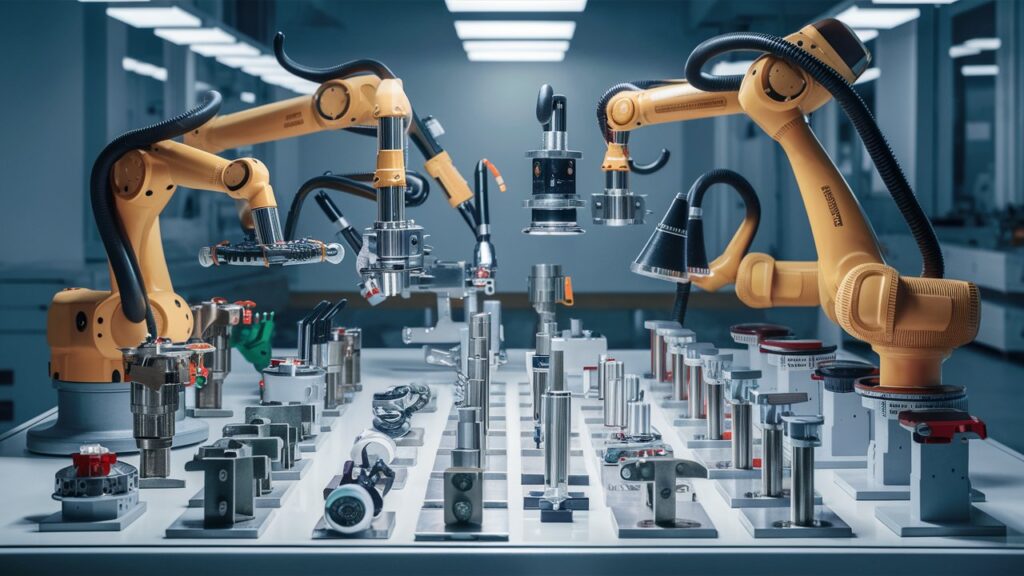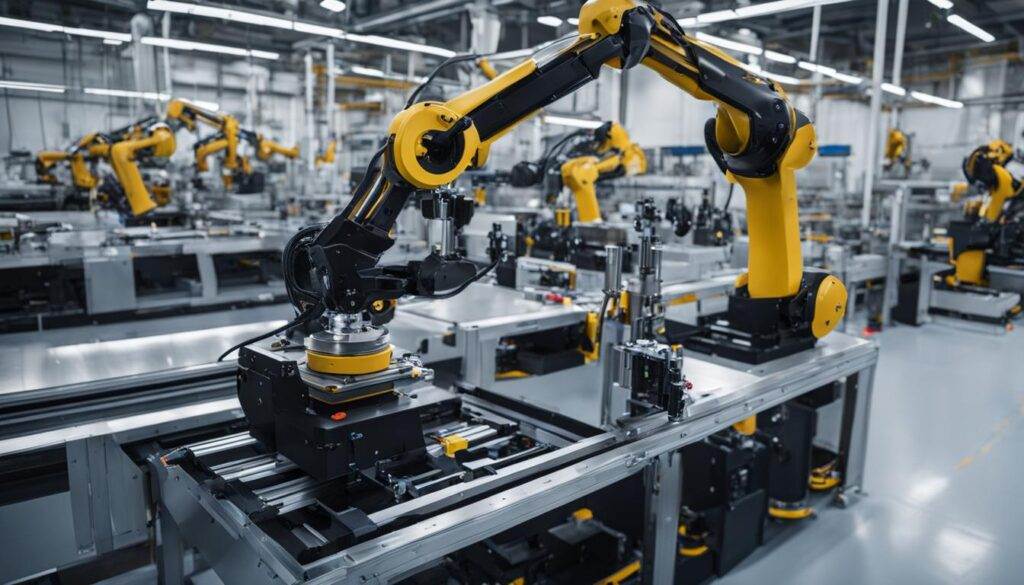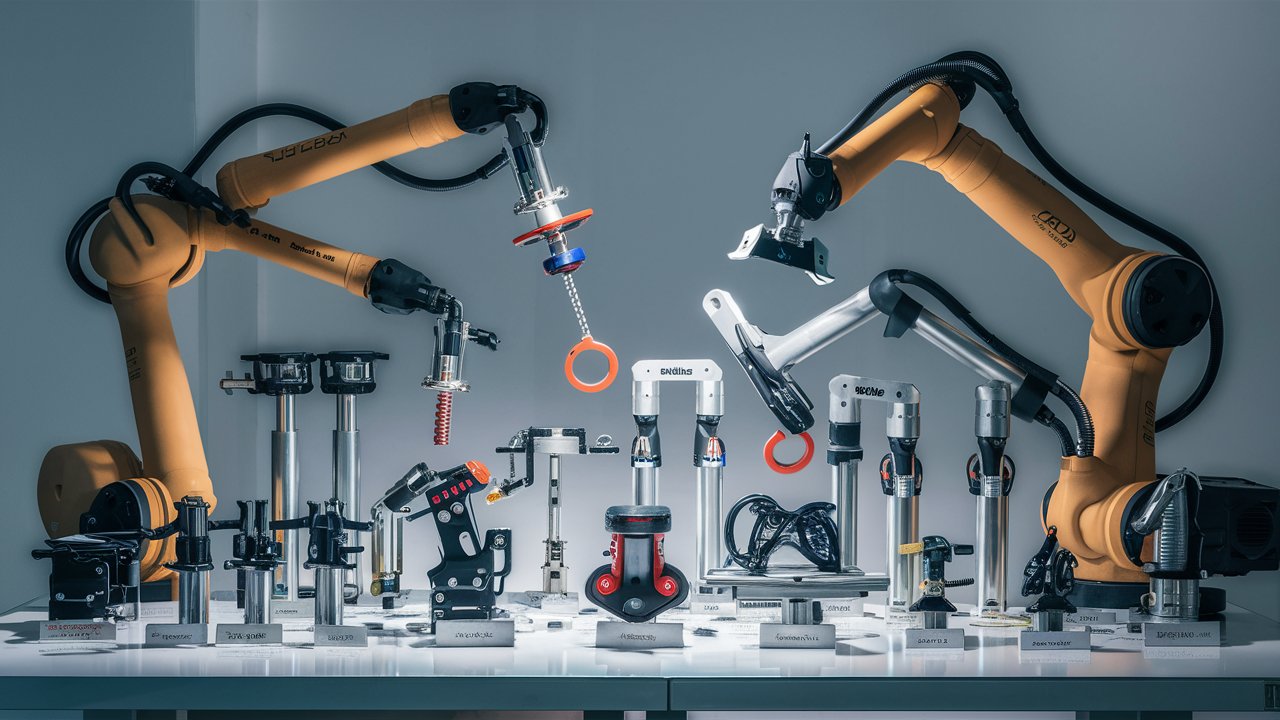Gain insights into the various types of end of arm tooling, focusing on critical robotic components and end effectors. This guide provides valuable information on EOAT solutions, addressing specific needs in robotic applications and industrial automation.
What Is End of Arm Tooling (EOAT)?
Defining EOAT and Its Importance
End of Arm Tooling (EOAT) is the set of devices that attach to the end of a robotic arm, helping it do different tasks. These tools are super important in places like factories and automation setups. EOAT includes things like grippers, sensors, and special tools designed for specific jobs. They help robots work faster and more accurately, which is key for many industries.
The Critical Role of EOAT in Robotic Applications
EOAT is really important in how robots operate. It boosts productivity and efficiency in various ways. For example:
- Increased Productivity: Robots equipped with EOAT can work nonstop without getting tired. This means they can produce more items over time.
- Enhanced Precision: Specialized tools make sure tasks are done correctly, which cuts down on mistakes.
- Versatility Across Industries: Different fields, from car manufacturing to electronics, use EOAT to create solutions that fit their needs.
Why Choosing the Right EOAT Matters
Picking the right EOAT is key for getting the best results while saving money. Custom EOAT solutions let businesses adapt tools specifically for their tasks. The right tooling mechanisms ensure that robots work well without wasting time or resources.
Components of EOAT
Grippers
Robotic grippers are essential parts of EOAT. There are different types:
- Vacuum Grippers: These use suction to lift things like boxes or glass.
- Pneumatic Grippers: These use air pressure to hold objects tightly.
Each type has its own uses depending on what materials need handling.
Sensors
Sensors are crucial because they give feedback during precise robot tasks. Force-torque sensors check how much pressure grippers put on objects, making sure nothing gets damaged.
Tool Changers
Tool changers add flexibility by allowing robots to switch between different tools quickly. This is really useful when a robot needs to do multiple tasks in one go, like moving from welding to assembly smoothly.
Specialty Tools
Specialty tools can be added to EOAT for specific jobs like welding or cutting. Some examples include:
- Welding Torches: Used for joining metal pieces together.
- Material Removal Tools: Handy for processes where exact material removal is needed.
These tools expand what robots can do.
How EOAT Integrates with Robotics
The Synergy Between Robots and EOAT
When robots and EOAT work well together, it makes operations smoother and better overall. Using suitable tooling means robots can handle complicated tasks more effectively than older methods.
Optimizing Robot Performance with EOAT
To get the best performance from robots using EOAT involves a few strategies:
- Understanding task needs: Knowing what each job requires helps choose the right tool.
- Regular upkeep: Keeping all parts working properly boosts reliability.
- Ongoing improvement: Looking at performance data helps refine processes over time.
Understanding EOAT Terminology
Essential Terms You Need to Know
Getting familiar with key terms related to automation technology helps understand how robotics works in production settings:
- Actuator: A device that moves or controls something.
- End Effector: The part of a robot that interacts with its surroundings; often used interchangeably with EOAT.
Knowing these terms makes discussions about robotics clearer and easier!
Popular Types of End of Arm Tooling
Grippers- The Most Common EOAT
Grippers are the most common type of End of Arm Tooling (EOAT) used in robotic applications. They help robots pick and move objects and come in different designs based on how they work.
- 2 Jaw Grippers: These are simple tools that work well for symmetrical parts. They grip firmly, making them a popular choice for assembly tasks.
- 3 Jaw Grippers: These provide more stability than 2 jaw grippers. They are great for holding oddly shaped items securely.
- Soft Grippers: Made from flexible materials, soft grippers can handle delicate objects without causing damage. They’re perfect for food processing or assembling fragile components.
- Vacuum Grippers: These use suction to lift objects, making them ideal for flat surfaces. They can manage various materials like glass and cardboard, which adds to their usefulness in different situations.
Welders and Cutting Tools
Welders and cutting tools make up another important category of EOAT. These tools boost what robots can do in manufacturing settings:
- Spot Welders: Often found in automotive manufacturing, spot welders quickly join metal parts together. Their speed is essential for high-volume production lines.
- Laser Cutters: Known for their accuracy, laser cutters allow for detailed designs and cuts that traditional methods might struggle with. This precision is key in industries that need intricate work.
Specialty End Effectors
Specialty end effectors give robotic systems the ability to take on unique tasks:
- Screwdrivers and Nut Runners: These automated tools make assembly lines faster by quickly fastening parts together, saving time and labor costs.
- Paint Sprayers: Widely used in automotive painting, paint sprayers ensure even coverage while minimizing waste. This technology helps improve both quality and efficiency.
- Polishing Tools: Great for finishing tasks where surface quality matters a lot, polishing tools deliver a high-quality finish that meets industry standards.
Tool Changers- Flexibility in Automation
Tool changers add flexibility to robotic systems by letting them switch between different EOATs quickly:
- Automatic Tool Changers: These allow robots to change tools on their own based on the task they need to do. This feature is important when multiple types of tooling are needed within one workflow.
- Manual Tool Changers: While not as common as automatic ones, manual tool changers provide budget-friendly options where frequent changes aren’t necessary but still offer some flexibility.
Understanding the various types of End of Arm Tooling—from grippers to specialized end effectors—helps industries optimize their automation solutions effectively.
How End of Arm Tooling Can Affect Application
Enhancing Productivity
Choosing the right end of arm tooling (EOAT) can really boost productivity in robotic applications. When robots use specialized grippers and tools made for specific tasks, they can work faster and more accurately. This leads to shorter cycle times and better throughput.
Using advanced EOAT solutions helps cut down the time it takes to complete each task. For instance, electric grippers or vacuum end effectors make pick-and-place operations quicker, which speeds up production rates. The right EOAT not only improves automation efficiency but also enhances manufacturing automation processes.
Improving Precision and Accuracy
Precision-engineered EOAT components like force-torque sensors and adaptive grippers help ensure consistent quality output in manufacturing. This is important in industries where even small mistakes can cause big problems.
Recent developments in robotics and EOAT design have created tools that provide greater accuracy than before. For example, using specialized tooling for injection molding makes sure that every piece produced meets strict specifications, boosting overall product quality while positively impacting application performance.
Impact on Safety
Picking the right end of arm tooling doesn’t just help with productivity; it also makes the workplace safer. Tools designed with safety features lower the risk of accidents during operation.
By using ergonomic designs and automated systems that reduce human interaction with dangerous processes, companies can greatly cut down on workplace accidents. Making sure operations are safe with suitable EOAT is key to keeping a secure industrial environment while promoting effective automation systems.
Cost Implications
While high-quality EOAT might need a bigger upfront investment, the long-term savings from increased efficiency and less downtime often make up for these initial costs. Businesses should look at their specific needs to find the most cost-effective solutions.
Exploring different types of end of arm tooling—like pneumatic grippers or custom-designed finger tooling—can offer solutions that fit budget limits while still meeting operational demands. Understanding cost implications helps businesses make smart choices about investing in custom EOAT solutions that boost economic efficiency without sacrificing quality or performance.

Innovations and Trends in EOAT
Recent Advancements
The use of artificial intelligence (AI) in end-of-arm tooling (EOAT) is changing how automation works. AI helps improve gripping strategies, making them more precise and adaptable to different payloads. This means smarter manufacturing processes that boost productivity. As industries adopt intelligent robotics, the role of AI in enhancing automation efficiency becomes increasingly important.
Electric grippers are becoming popular because they are efficient and versatile. These robotic end effectors allow for precise control over gripping force, which makes them perfect for handling delicate items or various materials. The rise of electric grippers shows how innovations can streamline operations while ensuring safety and reliability.
Customizable EOAT Solutions
Custom solutions are changing how manufacturers design EOAT. By customizing tools for specific tasks, companies can greatly improve productivity. Specialized tooling ensures that the right tool is used for each job, reducing errors and maximizing output.
Modern EOAT designs focus on flexibility and adaptability with modular components that can be easily adjusted or replaced. This approach minimizes downtime during production changes and boosts operational efficiency. Manufacturers benefit from a more agile environment where quick adjustments can be made as needed.
Sustainability in EOAT
Sustainability is now a key focus in developing EOAT systems. Manufacturers are looking into eco-friendly materials like biodegradable plastics and recyclable metals to reduce their environmental footprint. This shift not only meets regulatory demands but also aligns with consumer preferences for greener products.
Energy-efficient EOAT systems are gaining attention as energy consumption becomes a major concern in automation systems. New designs prioritize energy efficiency without losing performance, leading to lower operational costs while promoting sustainable practices in manufacturing.
Future Predictions
The future of end-of-arm tooling looks bright with exciting advancements ahead. Technologies like 3D printing allow for rapid prototyping of tools, enabling quicker changes based on real-world feedback. Adding smart sensors to EOAT will enable real-time monitoring and adjustments, improving overall system performance.
Emerging technologies such as collaborative robots (cobots) will require innovative EOAT designs that focus on safety while maximizing productivity. As these trends evolve, staying updated on robotic automation trends will be crucial for manufacturers who want to stay competitive in a fast-changing market.

Tips for Choosing the Right EOAT
Assessing Your Needs
When picking the right End of Arm Tooling (EOAT), start by looking at your specific application needs. Think about the materials you’ll be working with and the tasks at hand. Figure out how much weight your robotic system needs to handle, which is known as payload capacity. Also, consider how far the robot must reach to do its job effectively.
Compatibility with Existing Systems
Making sure your new EOAT fits well with your current systems is super important. Check that it works with your existing robotic setup and any other equipment you already have. If needed, look for options that allow retrofitting, so you can adapt new tools without changing everything. This saves time and cuts down on costs for your automation projects.
Considering Environmental Factors
Different work environments need different EOAT choices. If your tasks involve tough conditions or chemicals, opt for weatherproof and corrosion-resistant tools. For industries like pharmaceuticals or food processing, clean room EOAT is a must to avoid contamination. Picking tools designed for these environmental factors helps ensure they last longer and perform reliably.
Supplier Selection and Support
Choosing a dependable supplier is key to successfully using EOAT. Look for suppliers known for high-quality products that meet your needs. After-sales support matters too; make sure they provide training resources and ongoing help so you can get the most out of your EOAT solutions. A good relationship with a reliable supplier boosts overall performance.
Customization Options
Customization can really improve how effective your End of Arm Tooling is. Many suppliers offer solutions made specifically for unique applications or challenges in different industries. Check out options for specialized tooling that meets exact operational needs while ensuring great performance.
Cost Considerations
When looking at different EOAT options, think about both initial costs and long-term savings. Sometimes a pricier tool can be more durable or efficient, saving you money over time through lower maintenance costs or higher productivity rates. Always look at total ownership costs instead of just upfront prices to find cost-effective EOAT solutions.
Future-Proofing Your Investment
As technology in robotics and automation moves fast, it’s smart to future-proof your investment by choosing adaptable EOAT solutions that can work with new technologies like AI-driven systems or advanced robotics features. This planning ensures that your operations stay relevant as industry advancements come along.
By taking these factors into account when selecting End of Arm Tooling (EOAT), you’ll boost automation efficiency across various applications while ensuring safety and reliability in all operations.

